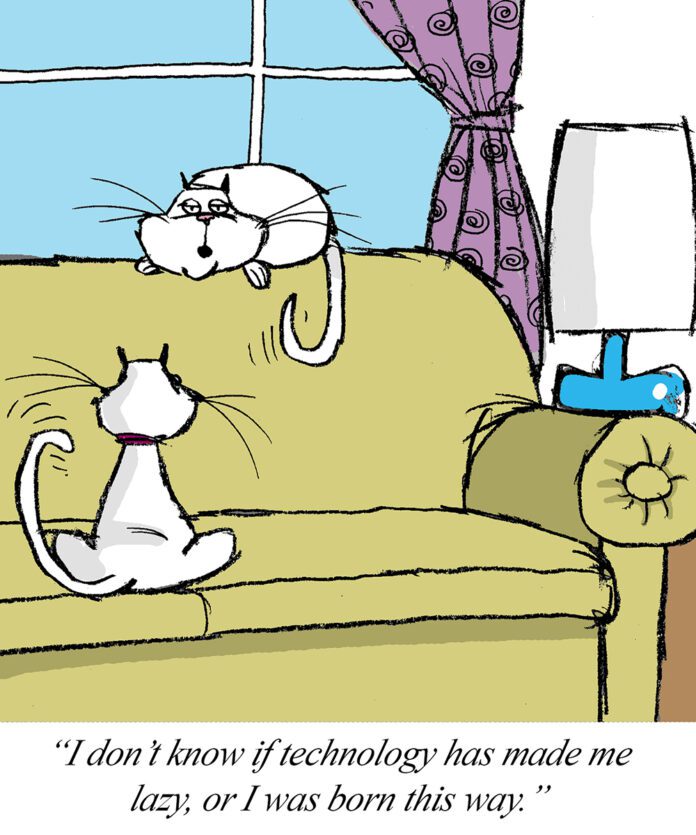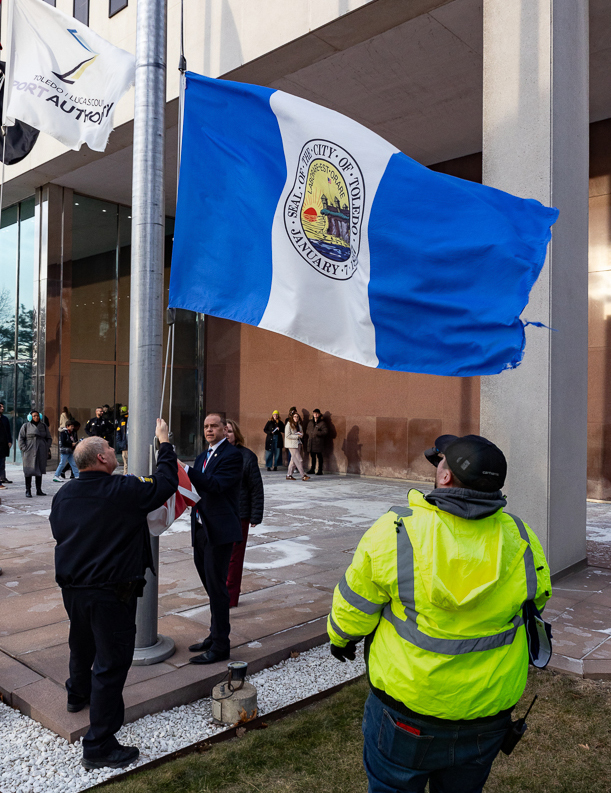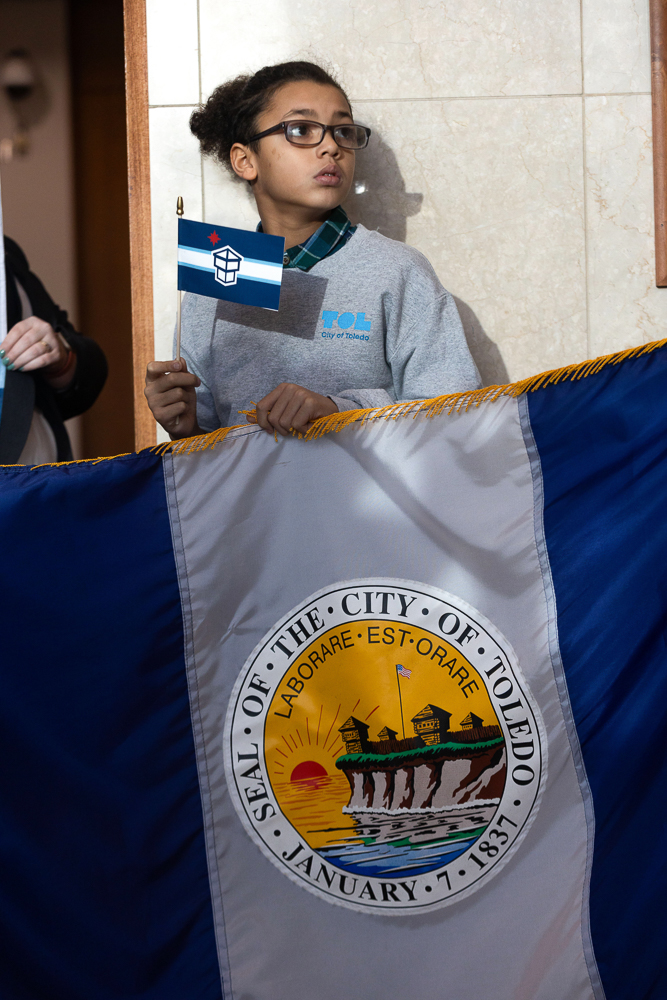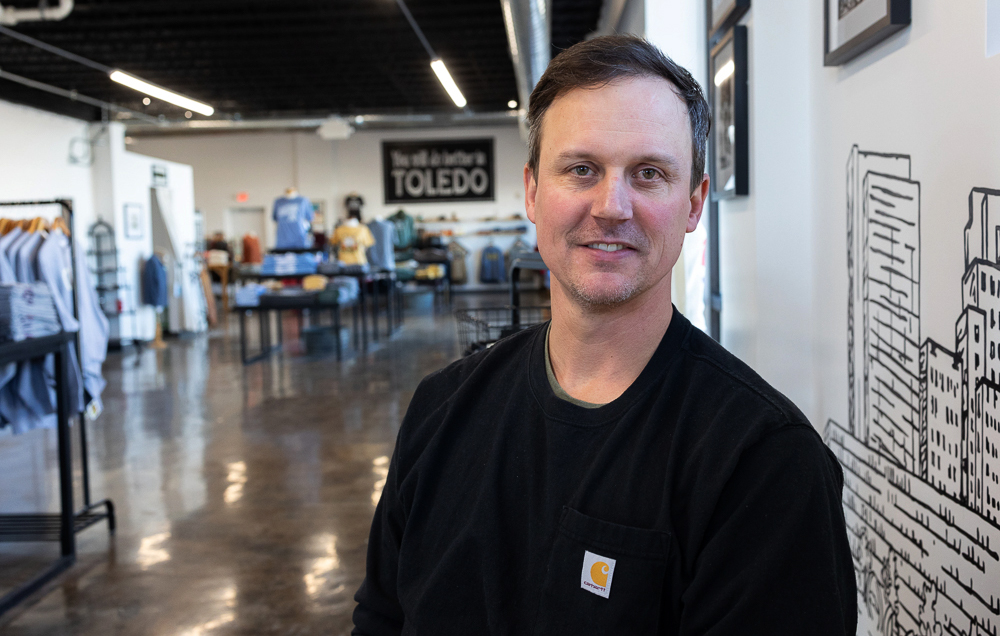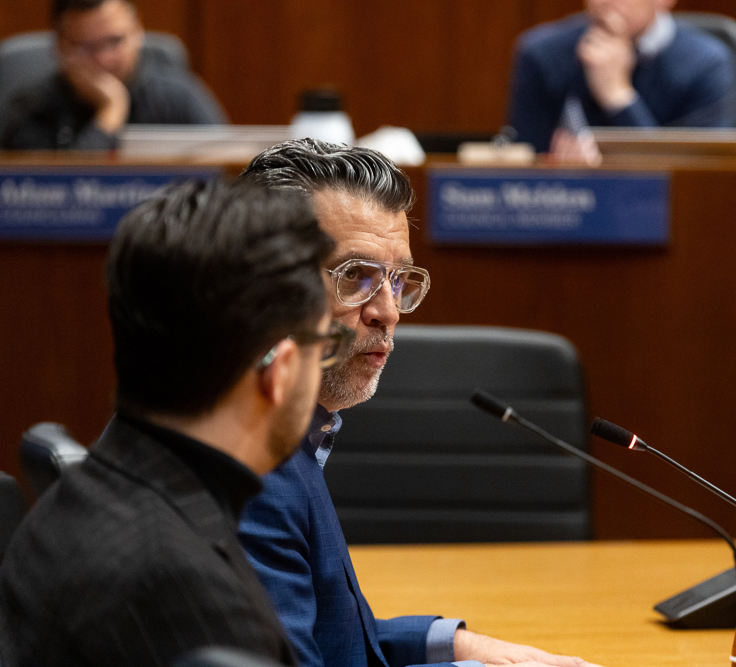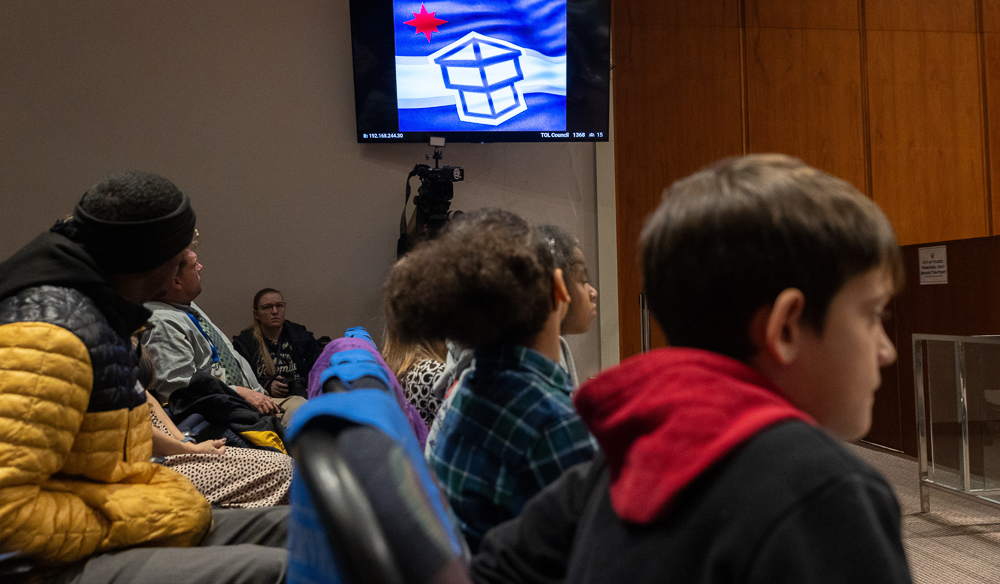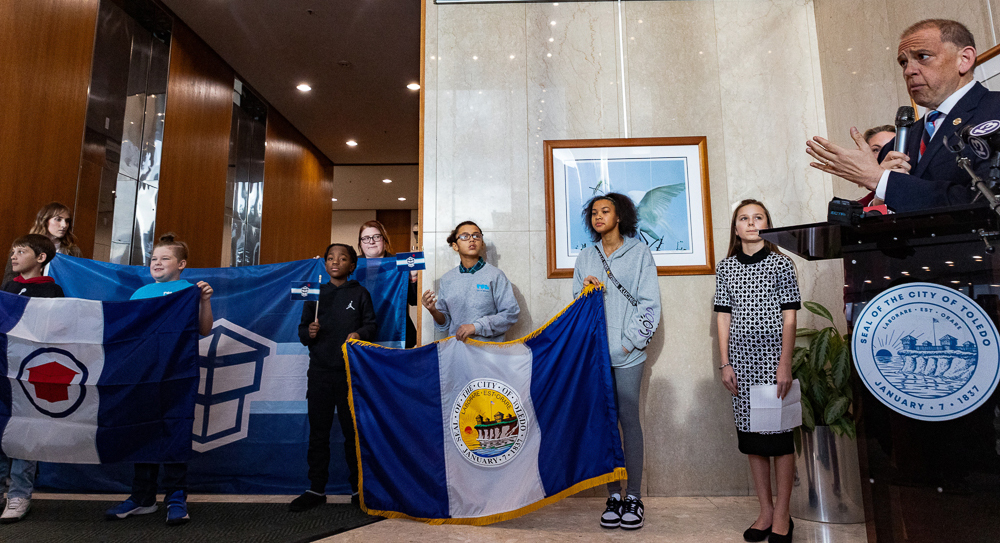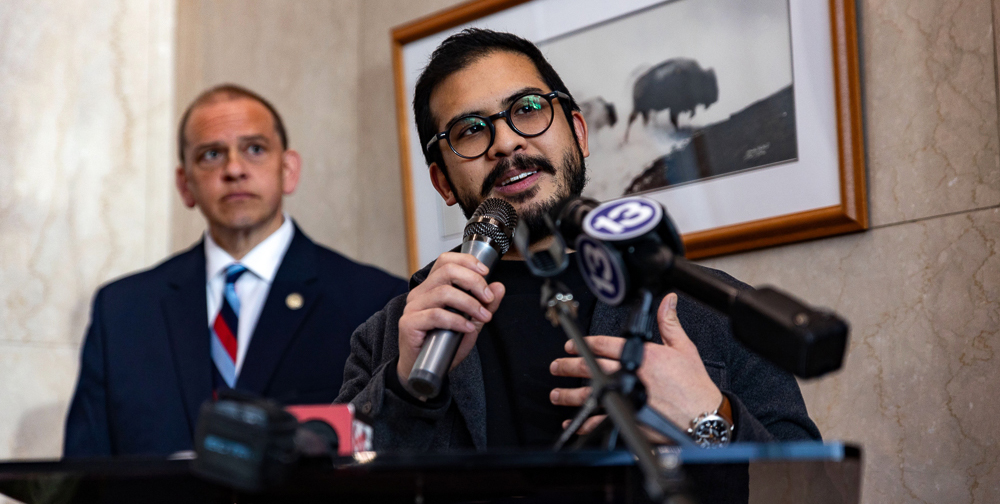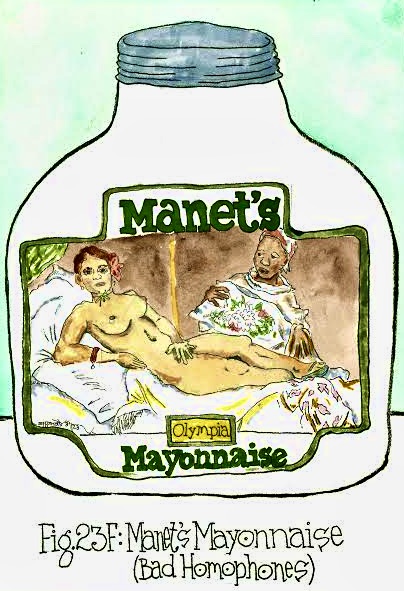Profile: UToledo Interim President Matthew J. Schroeder
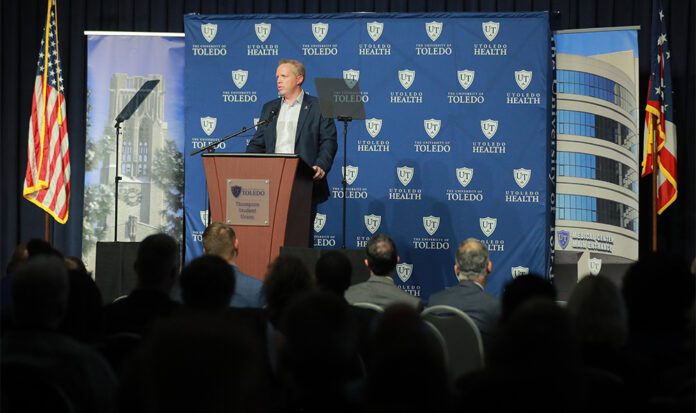
TOLEDO – When Matthew J. Schroeder, interim president of the University of Toledo, speaks to community groups about his current responsibilities and the future of the institution, he hears familiar stories: Memories of attending classes or events on campus, and family members who were graduates or had medical care at a facility affiliated with the school.
Those are stories he knows first-hand – starting with his years on campus as a commuter student from Toledo, and at times working two or three jobs while studying for his bachelor’s degree in management.
“Toledo was my choice. I didn’t look anywhere else,” he said.
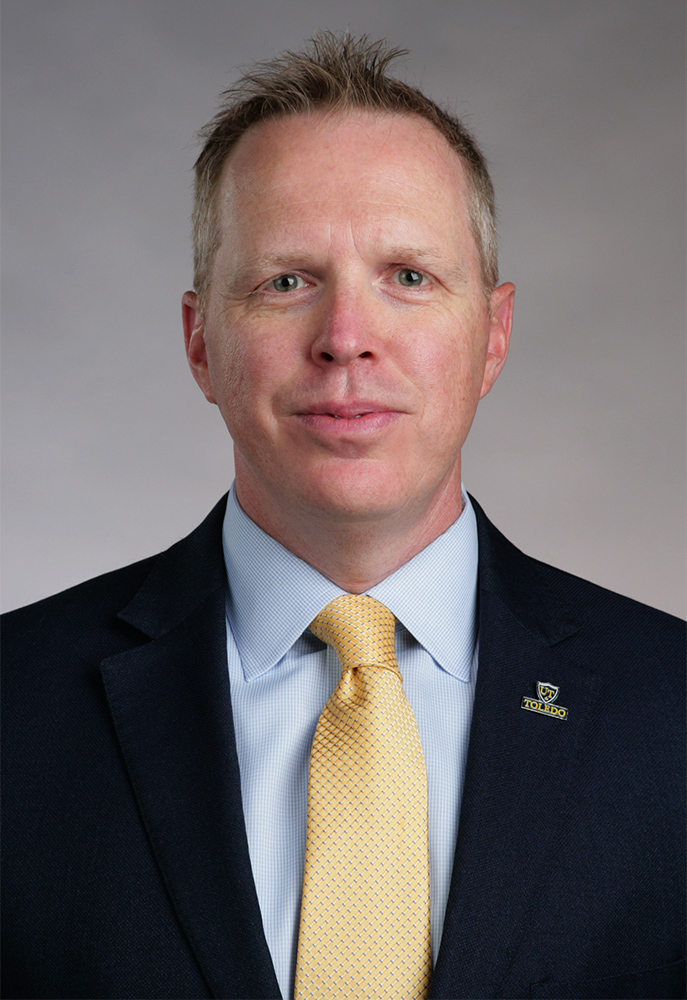
The paths to the academic buildings and hallways in University Hall were quiet when Schroeder sat for an interview on Dec. 18 with the Toledo Free Press to discuss his experience, so far, in the role. Students had wrapped up their exams on Dec. 13, and staff members were the only ones still on campus.
While his title is interim president, Schroeder insists he is not treating the role that way. His plan is to explore and present a vision for what a college president can do. He said the board of trustees gave him all the responsibility, authority, pressures… but also all of the opportunities of a campus leader during this time.
“We are resetting what a modern day university president looks like,” he assured.
Schroeder earned his master’s degree in business administration at the University of Michigan. He then worked in various leadership roles at UToledo, and also at the former Medical College of Ohio, which merged with the university in 2006.
Schroeder had served four years as chief of staff to former UToledo president Sharon L. Gaber before beginning his role in May as the school’s interim president.
During the past few months, he’s had a closeup look at a race car built by engineering students; participated in the homecoming parade; visited tailgate parties; presented his first State of the University address; and shook hands with the newest Rocket alumni when fall semester graduation took place on Dec. 14.
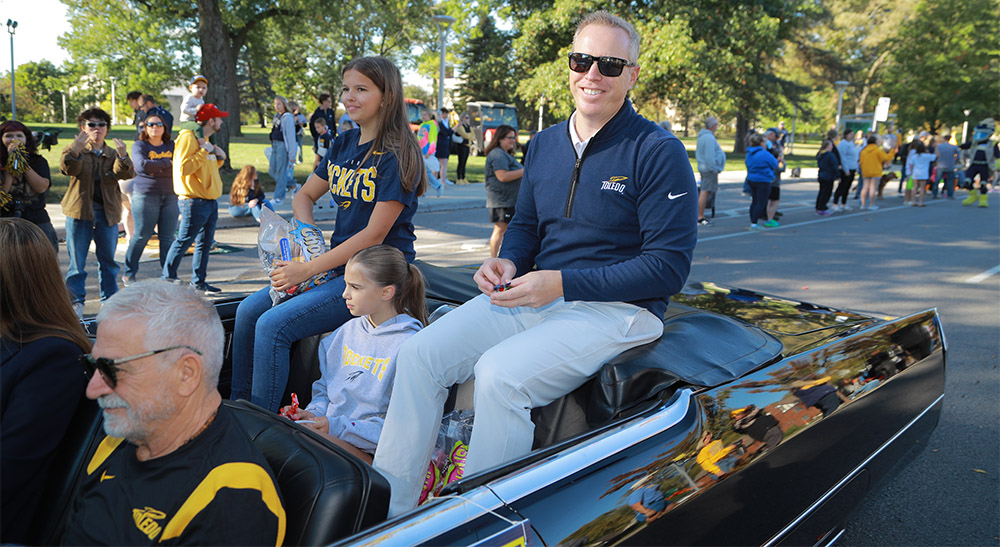
Meghan Cunningham, vice president for marketing and communications, said Schroeder even acted in a cameo in this year’s holiday video that featured UToledo’s mascot Rocky and student vocalists.
“He was a good sport!” she said about the filming.
On the topic of UToledo health services, his goals include making it easier to get appointments and recruiting physicians to serve in the community. The number of clinical trials are ramping up.
The success and reputation of recent faculty research also has resulted in bragging rights for the university, including winning competitive research grants.
“Matt Schroeder has focused UToledo on being the higher education powerhouse of northwest Ohio and beyond,” said Dr. Jerry Van Hoy, faculty senate president and associate professor of sociology, during the State of the University presentation in October.
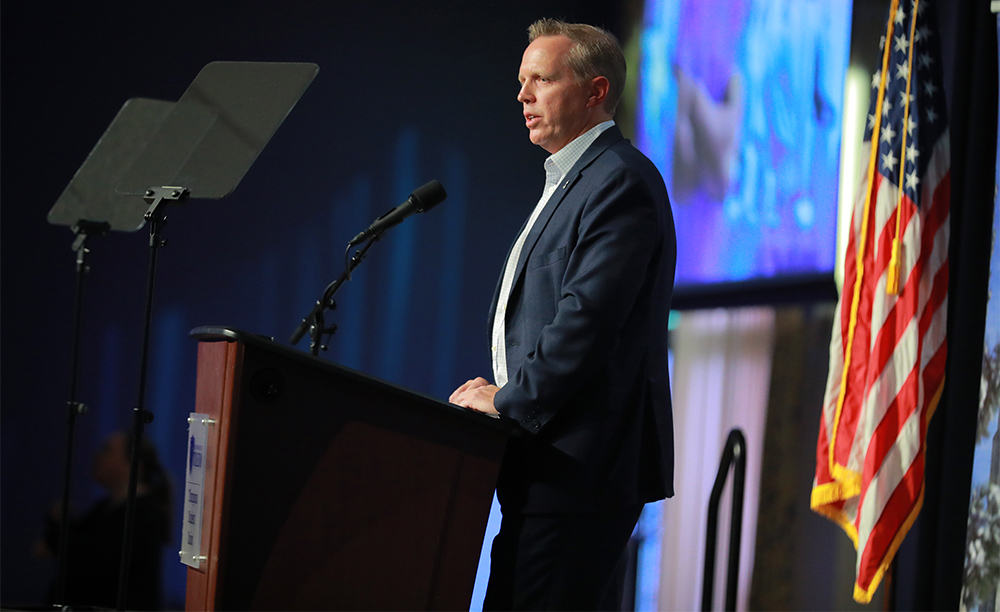
“He is developing and implementing a plan to leverage the education, the excellent educational research and clinical and community outreach successes of our institution to better serve our students and our region.”
Enrollment trends
One of the issues Schroeder has been blunt about is student enrollment trends. It came up in his State of the University speech, which was titled The Power to Do More.
“I often say we have a great story to tell. I know we do,” Schroeder said that day. “But I also will tell you that we can and must do more.”
Whether because of population demographics, overall questions about the value of a college degree, or the ripples of the COVID-19 outbreak (UToledo was among the schools canceling sports and shifting to remote learning in March 2020), it is a fact that the school has seen declines in enrollment during the past 10 years.
To reverse that trend, Schroeder called for a renewed focus on recruitment within the region, along with retention of students and a student success plan.
“We’re getting back to the fundamentals in terms of recruiting and retaining,” he said. The key to success is “winning in our backyard.”
Many of today’s students come from backgrounds similar to his – a working class family, from Toledo or just beyond, commuter student status, and having limited financial resources.
To address the concerns of those students, one of the pitches is that UToledo graduates end up with less federal student loan debt than their counterparts at other schools. Another pitch is providing and promoting innovative and relevant academics meant to prepare students for today’s workforce needs – a goal that faculty has been specifically asked to work on.
“We will review our degree programs to identify those that are in high demand now, in five years … and provide the resources to make them competitive,” he said during his remarks this fall. “If we do not have the programs students want to study, we will not be able to recruit them to UToledo.”
Now that the 2025-26 recruiting process is well under way, he is confident that the number of new students will be up in the incoming academic year.
“It will still take a number of years to be up in total enrollment,” he noted.
Schroeder encourages all students to get involved in campus events, organizations and activities – opportunities that he skipped as a commuter himself. “I missed out. It was my choice,” he said. Over time, he came to see that such activities complement and contribute to success in the classroom.
“Get engaged. Get involved,” he tells today’s students.
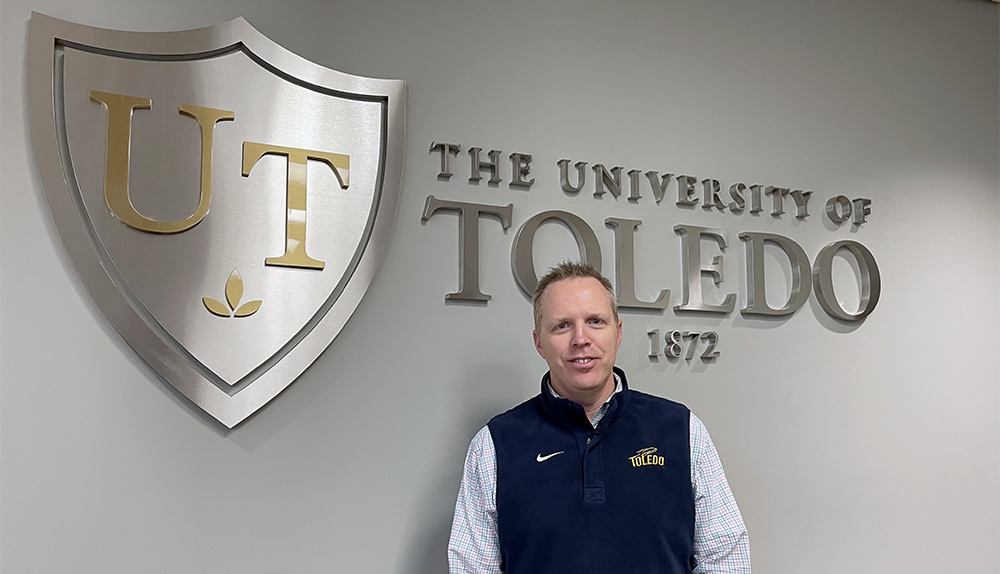
Interestingly enough, the students who experienced part of their high school or college years during pandemic restrictions are eager to do just that. Student participation in that demographic is much more noticeable than in previous years.
“You can see many of them making up for lost time,” he added.
Quick look at UToledo
University of Toledo is a regional public university serving northwest Ohio and southeast Michigan, with its origins dating to the creation of Toledo University of Arts & Trades in 1872.
The current main campus on West Bancroft St. began with the construction of University Hall in 1931. UToledo also has three other campus sites.
Significant steps include becoming part of the state university system in 1967 and a merger in 2006 with the former Medical College of Ohio. While it is a public research facility, it also is an academic medical center with health services run under the brand UToledo Health.
As far as athletics, student athletes compete in NCAA Division I sports through the Mid-American Conference. Students also can get involved in than 400 student organizations, including about 30 fraternities and sororities.
The fall 2024 enrollment was 14,400 students, or around 11,800 in full-time equivalent numbers. About 26 percent are first-generation students, according to the presidential leadership profile. The international students come from more than 80 countries.
Most of UToledo’s students are commuters, either from home or in privately run apartments in the neighborhood. There are five residence halls on campus housing about 1,600 students.
Presidential selection process
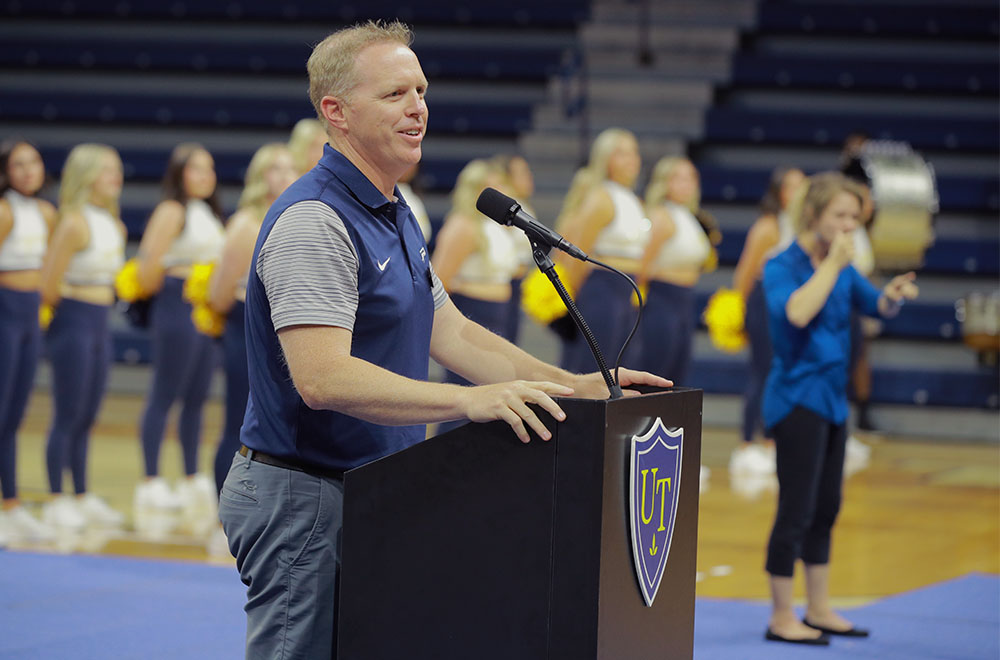
The University of Toledo Board of Trustees plans to have its next president in place before the fall 2025 semester begins, according to details posted on the university website.
The search is led by co-chairs UToledo Board of Trustees Chair Patrick J. Kenney and UToledo Trustee Stephen P. Ciucci; Education Executives is the consulting firm hired to assist.
The Presidential Profile Committee, announced in October, has issued its “leadership profile” report, which includes the following:
The University of Toledo seeks a President who understands the exceptional opportunity this University presents. The University is recruiting a visionary leader committed to imagining the potential of this institution and who will leverage its excellent resources for the 21st century. In so doing, UToledo will set the benchmark for what a public research university can and should do for its community and the world.
The formation of the Presidential Search Committee was announced Dec. 4. That group includes community leaders, university trustees, faculty and students – along with some people from the presidential profile committee.
Ohio’s minimum wage increase compared to other states
Economic Policy Institute states Ohio’s minimum wage is still too low to ‘maintain a modest, but adequate, standard of living.’
This story was originally published by Signal Statewide. Sign up for their free newsletters at SignalOhio.org/StateSignals. Statewide is a media partner of the Toledo Free Press.
Frank W. Lewis | Signal Statehouse

Ohio is one of 21 states that raised its minimum wage on New Year’s Day. The minimum wage in Ohio rose to $10.70 per hour for non-tipped employees, an increase of 25 cents. For workers who receive tips, the minimum wage went up 10 cents to $5.35 per hour.
The raise in Ohio will affect more than 300,000 people, according to the Economic Policy Institute, a nonpartisan organization that advocates for workers. The institute’s research shows that almost 90 percent of people benefitting from all state increases this year are adults, 58 percent are women and 20 percent are in families living below the federal poverty line.
In Ohio, the increase is required by a constitutional amendment, passed by voters in 2006, that ties the minimum wage to the rate of inflation.
Not all Ohio companies have to raise the minimum wage they pay. The increase only applies to companies with more than $394,000 in gross revenue per year. Those earning less must pay at least the federal minimum of $7.25 per hour.
How does Ohio’s minimum wage compare?
Nationally, Ohio’s non-tipped wage is now in the middle of the pack — lower than the rate in 25 states and higher than in 24, according to data gathered by the National Conference of State Legislatures.
Still, “There is no county where an Ohio worker can earn less than $17.73 an hour and maintain a modest, but adequate, standard of living,” EPI reported.
Michigan’s rate is lower right now, $10.56, but will rise to $12.48 in February. Three more planned annual increases will bring it to almost $15 in 2028.
Three states — Illinois, Delaware and Rhode Island — raised their minimums to $15 this year, bringing the total number of states paying that much or more to 10.
In 2024, the Raise The Wage Ohio campaign proposed a new constitutional amendment that would have boosted the minimum to $12.75 this year and to $15 on Jan. 1, 2026, for non-tipped and tipped workers. The campaign fell short of the required number of petition signatures to get the amendment on the ballot in November but vowed to keep working and try again in 2025.
“A $15 minimum wage by 2026 would benefit nearly 1 million workers,” according to Policy Matters Ohio, “giving them on average an additional $2,128 in their pockets each year for full-time work, and bringing over $2 billion in additional wages to low-paid workers in Ohio.”
Bluegrass in Super Class Winterfest
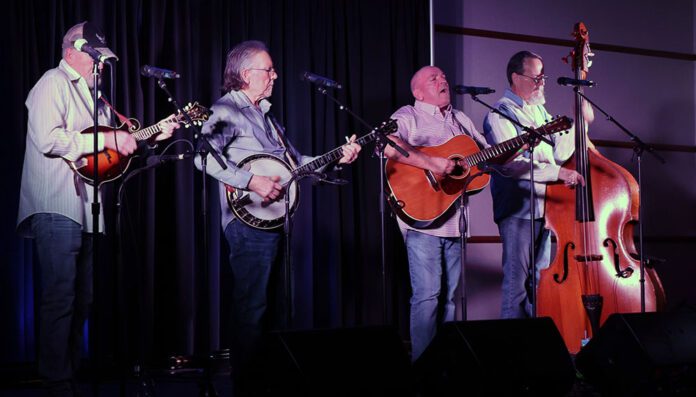
OREGON – The fast tempo and sweet, harmonious sounds of mandolin, bass, banjo and guitar have traveled from the tip top of the Appalachian Mountains, down the plains of Kentucky, and landed right here at the Maumee Bay Lodge.
Larry Efaw, mandolinist of the Larry Efaw & Bluegrass Mountaineers, started the annual Bluegrass in Super Class Winterfest 36 years ago with his wife, Lisa.
“We started this for the love of the music,” said Efaw.
Being a musician himself and having family and friends of the same accord, it seemed natural to bring everyone together and jam.
Originating in the rural south in the 1930s, bluegrass is traditionally acoustic and includes banjo, guitar, fiddle, mandolin and bass. Unlike country music, bluegrass is high-pitched, with each musician taking turns playing the melody while the other band members provide the backing. As the father of bluegrass Bill Monroe acutely described, bluegrass has a high, lonesome sound.
“This started as a family event, and we want that to continue. I started playing music with my dad 60 years ago; being on stage with dad so long this really makes me miss him,” said Efaw.
The Efaw family isn’t the only family with bluegrass roots; many of the other bands on the roster for the Bluegrass in Superclass formed with family members.
Kicking off the event Thursday was the Ottawa County Bluegrass Band, with brothers Joe and Denny Mitchell from Port Clinton. The Mitchells are known throughout Ottawa County and beyond for their family’s musical talents. In the 1990s, Joe (banjo) and Denny (guitar) played bluegrass with their dad, Joe, who played the mandolin, but he has since passed.
Other members of the band include Danny Bryant on mandolin, who currently lives in Fostoria and is from Whitesburg, Kentucky, and Simon Edwards on upright bass, who currently lives in Waterville and is from Flat Gap, Kentucky.
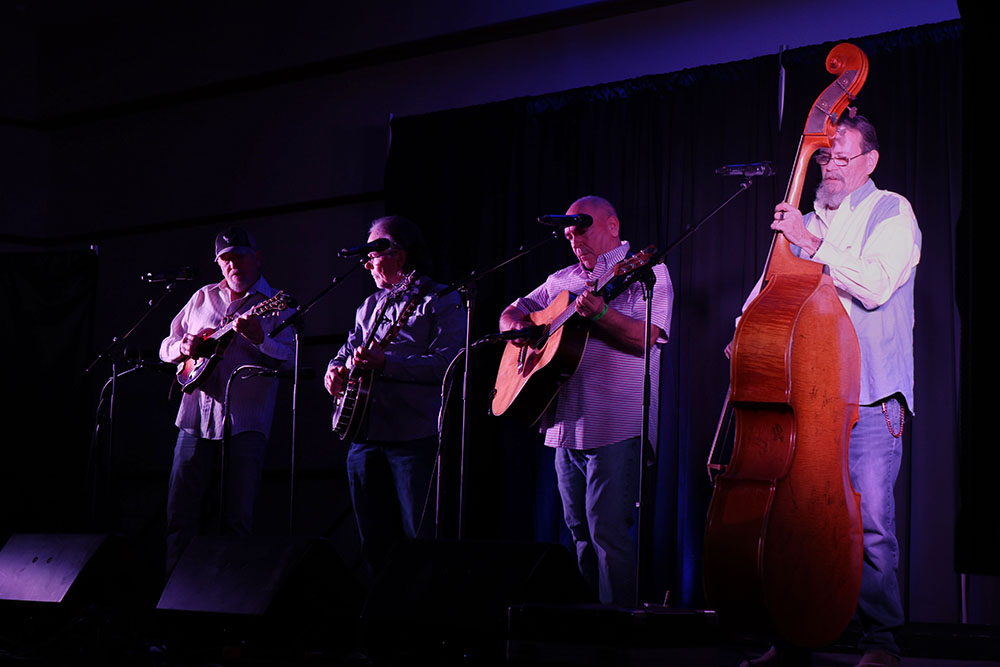
The familial bonds and sense of community are strong among these musicians and festival goers; so strong that every year the festival gives back to the community with its earnings. This year, proceeds from the festival will go to the American Brain Tumor Association and, specifically, to one local individual suffering from brain cancer.
Efaw also said one of the goals of the festival is to bring national acts to northwest Ohio. At this year’s festival, Rhonda Vincent will perform on Saturday, which is the last day of the festival. Vincent is the Grammy winning Queen of Bluegrass and is a Grand Ole Opry member. Her career also started in her family’s band, The Sally Mountain Show.
The weekend lineup:
Friday:
- Little Roy & Lizzy Show
- Harbourtown
- Lorraine Jordan & Carolina Road
- Larry Efaw & Bluegrass Mountaineers
- Open Highway
Saturday:
- Rhonda Vincent & Rage
- New Outlook
- Dean Osborne Band
- Larry Efaw & Bluegrass Mountaineers
- 7 Mile Bluegrass
The Bluegrass in Superclass Winterfest ran from Jan. 9-11 at the Maumee Bay State Park Lodge and Conference Center in Oregon.
TPS magnet programs provide ingenuity, innovation, exploration
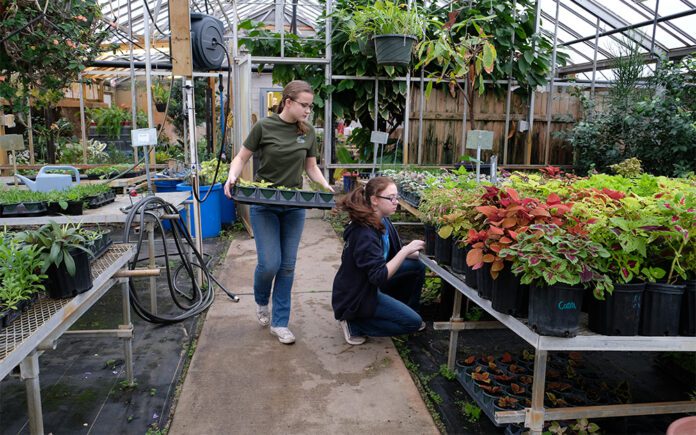
Story by Nate Light | Photos by Lori King
Toledo Public Schools (TPS) has taken a bold step into the future of education with its seven magnet programs offering students an opportunity to explore specialized fields of study and gain hands-on experience in emerging industries.
Each school focuses on a unique industry or specialization, ranging from aerospace technology, pre-medical health sciences and early college prep to engineering. This wide variety allows students to choose the specialization that interests them. It also allows teaching professionals to partner with industry leaders, designing a curriculum tailored to industry needs.
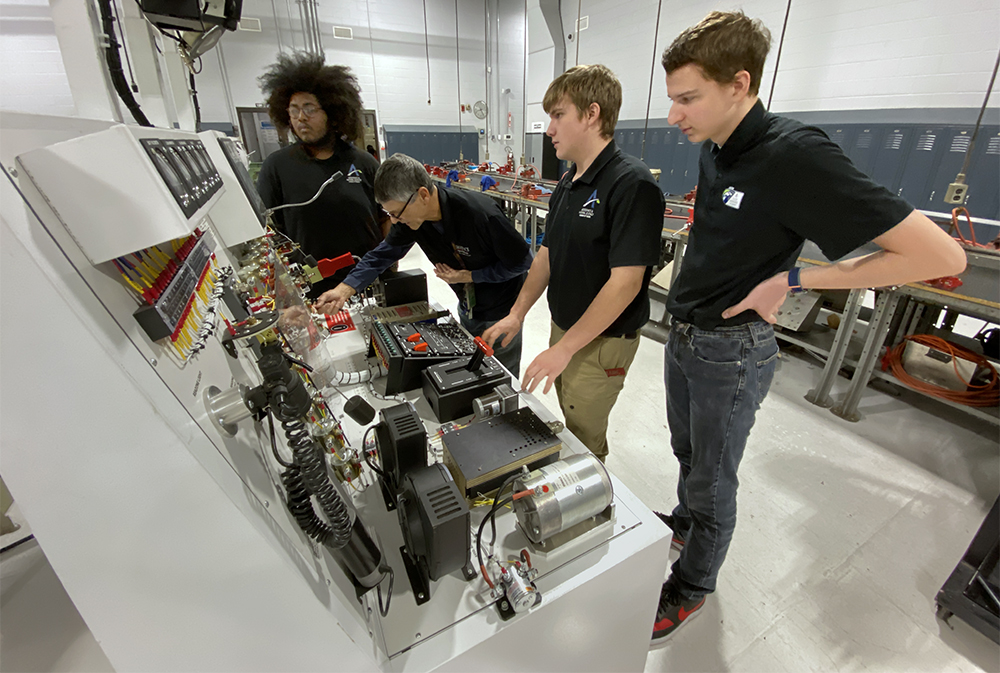
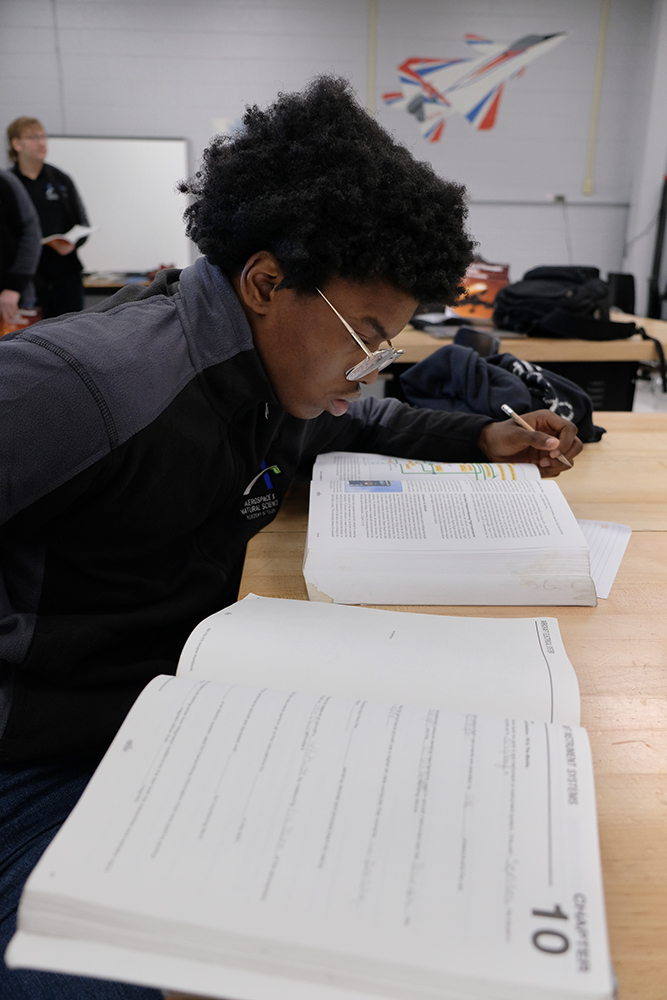
Jim Gault, the executive director of curriculum, highlighted that “we have partnerships with General Motors, Tesla and other organizations. All the students there do a capstone senior project, where they actually go and are working in various agencies and shops on engineering projects.”
In 2023, Toledo Early College’s state assessment placed them in the top 2 percent of schools nationwide and as the #1 magnet school in Ohio, with Toledo Technology Academy of Engineering ranking in the top 5 percent of schools nationwide. The most recent assessment granted TPS a number of 5-star ratings.
The Toledo Academy of Technology campus was nothing short of impressive. From electronics circuitry and electric vehicles, to advanced manufacturing techniques, robotics, 3D printing and mock wind turbines, the facilities and programs are setting students up for success in the 21st century workforce.
Electric vehicles: Driving the future
The academy’s curriculum doesn’t only focus on traditional electronics. Students also dive into the world of electric vehicles (EVs), a rapidly growing industry. In well-equipped workshops, learners explore the mechanics of EVs, batteries, motors and the technologies that drive these machines.
With hands-on projects, like converting an old gas Corvette into an electric vehicle, and a training car directly from Tesla, these students are offered a unique perspective on emerging industries. By exposing students to such cutting-edge fields, TPS ensures its graduates are prepared for careers in automotive innovation and clean energy solutions.
Students also learn critical safety protocols, such as how to identify and shut down high-voltage kill switches in EVs during emergencies. This training emphasizes the importance of safety in working with powerful electrical systems and ensures students can handle potentially dangerous situations confidently and effectively.
Advanced manufacturing: Milling machines and 3D printing
Another exciting highlight of the Toledo Academy of Technology is its focus on advanced manufacturing. The school boasts industrial grade milling machine and a host of 3D printers, enabling students to bring their ideas to life through precision machining and digital design.
Whether it’s creating prototypes or learning about industrial production processes, students are provided with hands-on experience in a field that is integral to manufacturing and engineering careers.
In particular, the use of 3D printing offers students a creative and technological edge. From designing parts in computer-aided design software to watching their models materialize layer by layer, the program fosters innovation while teaching critical skills that align with the demands of today’s industries.
Learning with FANUC robots
A unique aspect of the academy’s program is its inclusion of FANUC robots, a staple in traditional automotive engineering and manufacturing. These robots are widely used in industrial settings for tasks such as assembly, welding, and material handling. Students are taught to program and operate these sophisticated machines, gaining firsthand experience with technology that powers modern production lines. This exposure not only enhances their technical knowledge but also equips them with skills highly sought after in the automotive and manufacturing industries.
A modern hub for hands-on learning
The Toledo Technology Academy of Engineering stands as a beacon of innovation in education. The school is equipped with cutting-edge facilities designed to immerse students in real-world, technical learning environments with machinery and technology that mirror industry-level projects.
One standout feature of the academy is its focus on electronic circuitry. Students work on intricate circuit boards, learning to build, troubleshoot, and design systems that reflect the foundational skills needed for careers in electronics and electrical engineering. This hands-on approach allows students to apply theoretical concepts while fostering problem-solving.
Preparing students for tomorrow
These programs are especially critical in a time when STEM fields (Science, Technology, Engineering, and Mathematics) are driving economic growth. By integrating STEM-focused curricula into their magnet programs, TPS is positioning students to become future leaders, innovators, and problem-solvers in a competitive global economy.
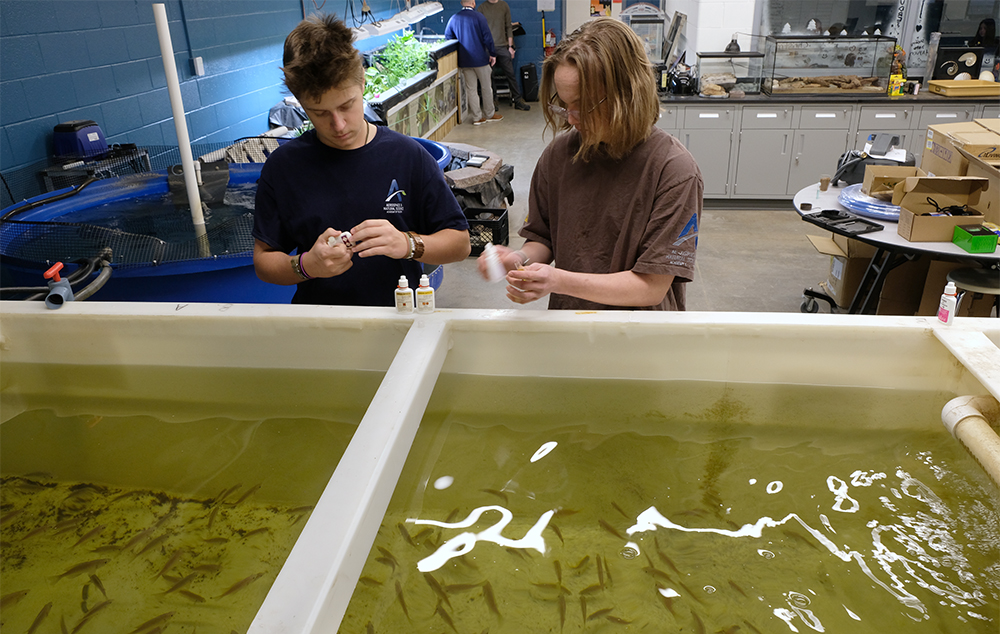
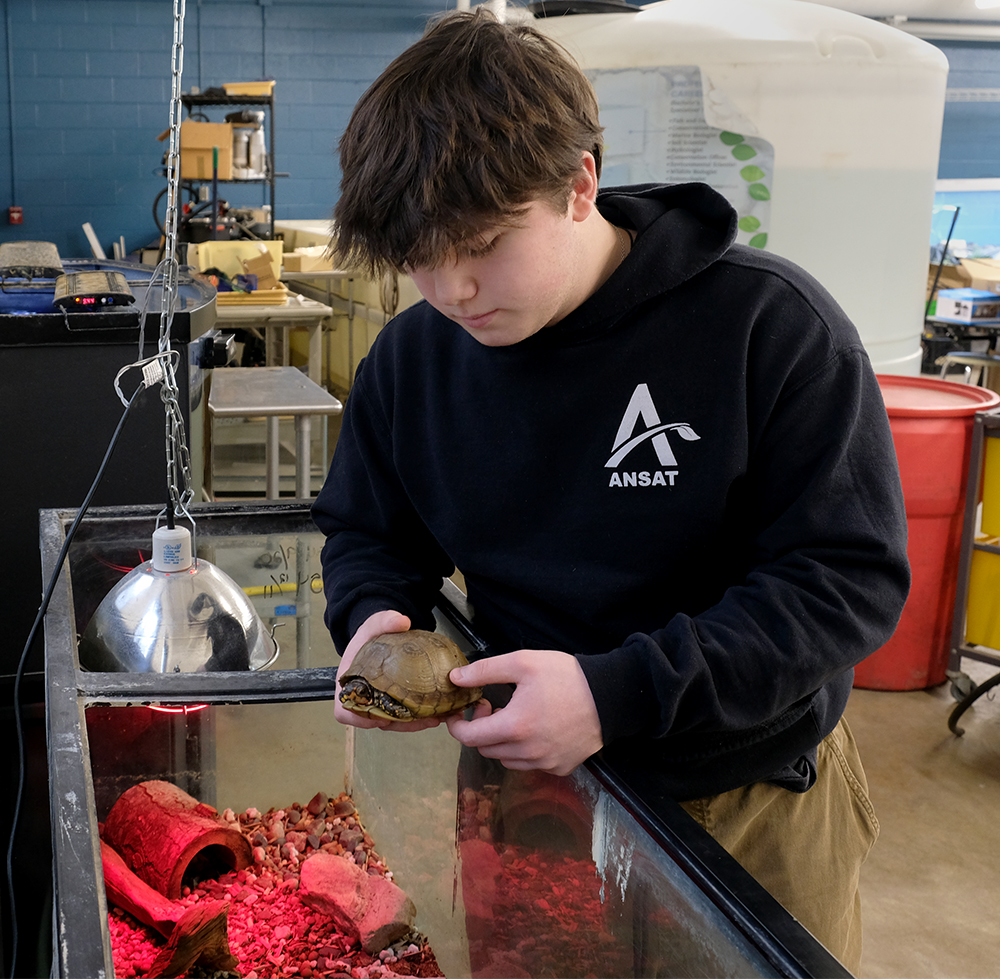
“These schools are very diverse,” added Gault. “You will have students from the city, from the suburb, and rural areas. You will have economically disadvantaged students, and students who are enriched from a financial background. Students of different races and religions. And I think that also plays well into the success of these schools. I think those different perspectives, and having to work together around projects and teamwork, lead to students being able to think critically. And if students are thinking critically, they will pass any test from the Department of Education.”
TPS’s commitment to hands-on, specialized learning is a testament to their vision for the future, and the results are already evident. The future is here, and it’s being built in Toledo classrooms.

Italian Bowl XLIV returns to UToledo’s Glass Bowl
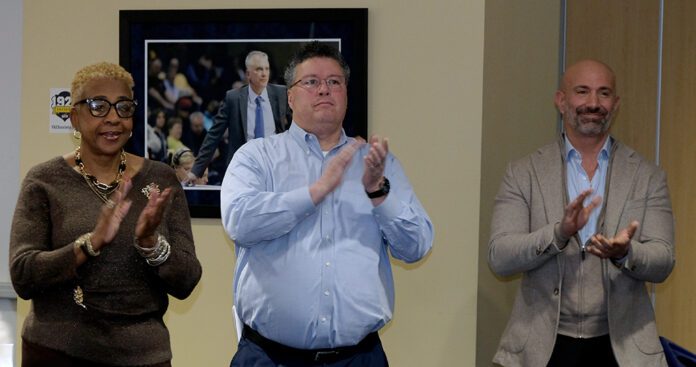

Most sports fans around the globe call it “football.” In the United States we call it soccer. So, what does one say when Italians play American football? Un pomeriggio fantastico!
During World War II, American servicemen stationed in Europe played American football all over the region, including Italy and France, for relaxation. American football in Italy achieved its present fame thanks to the inaugural “Spaghetti Bowl” on Jan. 1, 1945.
The game between the U.S. Fifth Army Krautclouters and Twelfth Air Force Bridgebusters was played in front of 20,000 fans at Stadio Giovanni Berta in Florence.
Army won the game 20-0.
For decades, Italians playing American football have competed for their own Super Bowl, the Italian Bowl Championship, which determines the league champion of the Italian Football League (IFL).
On July 1, 2023, the IFL championship was played on American soil for the first time in 40 years at the University of Toledo’s Glass Bowl. The Parma Panthers defeated defending champion Firenze Guelfi for the Italian Bowl XLII title in front of an estimated 10,000 fans, many of whom made the trip from Italy.
And in June, it’s coming back. The Italian Bowl is returning to Toledo!
At a press conference Wednesday at the University of Toledo, game organizers and local and state officials met at the Grogan Room at Savage Hall to announce that Italian Bowl XLIV will be played at the Glass Bowl.
Events related to the Italian Bowl will begin in March and culminate with the game on June 28. Italian Bowl XLIV will be televised live on BCSN, which will also televise IFL regular-season games.
Geoff Shook, president of Buckeye Broadband, said the 2023 Italian Bowl at UT “was an absolutely phenomenal success.
“The community embraced it,” he said. “So much so that when the next opportunity came around, the IFL was happy to meet with us and happy to take advantage of our invitation to come back. I love the fact we have the opportunity to work with other business leaders and help promote Toledo.”
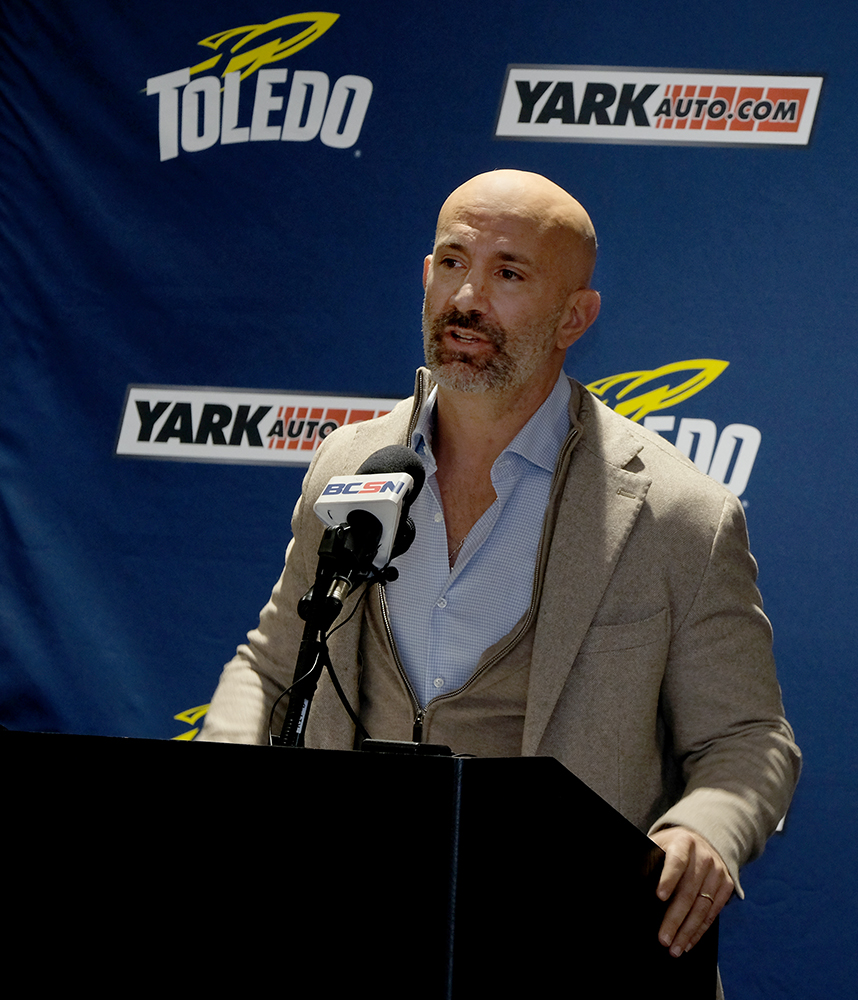
Shook added that the genesis of this event coming to Toledo two years ago can be attributed to “Nick Eyde’s vision.”
Eyde, a Lansing, Mich., native and Toledo real estate executive, played quarterback at a small college in Minnesota before going on to play five seasons in the IFL and two seasons in the Austrian League.
Eyde formed partnerships with community leaders, including the University of Toledo and BCSN, to help bring the Italian Bowl to the Glass City in 2023.
“It’s exciting for me,” Eyde said. “It’s a huge part of my life. Coming back to Toledo and playing in the Glass Bowl at the University of Toledo’s campus; it’s very special.”
Eyde gave a shout out to BCSN for televising IFL games, and he thanked UT director of athletics Bryan Blair “for being such a big proponent of this, as well.”
The partners here locally – I just cannot say enough. A lot of good things continue to happen and I’m excited to bring the Italian Bowl back on June 28.
Nick Eyde
“The partners here locally, I just cannot say enough,” Eyde said. “A lot of good things continue to happen and I’m excited to bring the Italian Bowl back on June 28.”
Blair said the university couldn’t be more excited to host an event like this, “not only for the city but for our campus and its beauty and all it has to offer.
“The Italian Bowl is going to invite not only this region but the entire world to ask more questions about what is Toledo?” Blair said. “Why Toledo … and why not Toledo and all the amazing things that, in my two and a half years here, I’ve found out about this amazing community.”
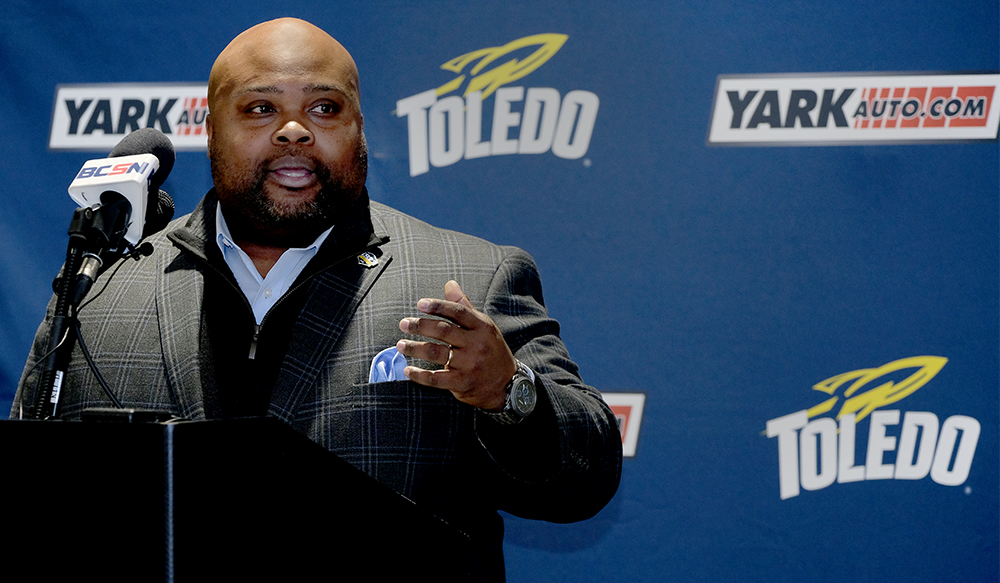
State senator Theresa Gavarone, from Bowling Green, expressed how excited she is to bring an international event, such as the Italian Bowl, back to Toledo.
“When you can bring people and countries together through sports, it can be a really great unifier,” Gavarone said. “We can start to build upon relationships. You’ve heard about the immediate economic impact of bringing Italy, this Italian game, here to our community.”
She noted the long-term benefits of those relationships really cannot be overstated. “This is an incredible opportunity to show leaders and business leaders what we’ve got here in Ohio.”

